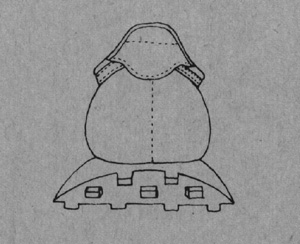
The Inclined Saw-tooth Theory helped me be less discouraged about my slow days and less overenthusiastic about my fast ones. A relatively bad day seemed almost inevitably to be followed by a good one, and after a super-good day, the next one was often a bit of a letdown.
Safety Precautions
Here are three exercise tips which will help you avoid pain and injury, and make exercising more enjoyable: warm up, warm down, and wear good shoes.
If you are walking at a moderate pace, you may not need to do any special stretching before you start—just start out a bit slower than your normal pace. But if you experience stiffness, tightness, or pain, start out with a few simple stretches. If you're running, you'll almost certainly be more comfortable if you start and end your regular stint with some stretching. The single most important part of the body for most runners to stretch is the Achilles tendons—the thick cords that run down the back of the foot just above the heel. Some runners are able to go out without stretching—by beginning at a reduced pace. Experiment. Exercise with and without stretching on two consecutive days, and pay close attention to the way your joints and muscles feel.
When you return from exercising, take a few minutes to make the transition from an exercising to a resting state. It's best not to stand still. The movement of your leg muscles has been helping to pump the blood back to your heart. It's best to either keep walking around slowly, or to sit or lie down with your legs up. Standing still places an extra load on your heart.
You may be perspiring and you're no longer generating the heat you were while exercising. Be careful not to let yourself become chilled. Many exercisers like to end their session with a hot bath or shower—this prevents chilling and helps keep the muscles relaxed.
A good, comfortable pair of walking or running shoes can turn your daily exercise period from a chore into a pleasure.

I encourage you to indulge yourself in this area. Get the best shoes you can possibly afford—and then some. It will be money well spent.
If you're walking and already have some comfortable walking shoes—fine. If you don't, or if you're running, I'd strongly suggest a pair of top-quality running shoes.
The kind you want is called a "training flat." They have wide heels and thick soles and are sold in stores that specialize in running shoes. Staff members at these stores are usually runners themselves, and can give good advice on shoe selection. Runner's World magazine puts out a special running shoe guide each year, and most stores will have a copy of the most recent guide on hand. Stick to the top-rated brands, but try on a number of different models. They will all be top quality, so you'll be looking for one with a shape that best matches the shape of your own foot. Be sure to try them on with the same kind of socks you'll be wearing when you use them.
A Natural Psychotherapy
While the desire to lose weight and the urge to be protected from heart disease would be reason enough to exercise, and while that is often the reason people begin exercising, veteran exercisers list changes in their consciousness and personality changes as the main reasons that keep them at it.
The studies I researched documented many benefits of exercise. A recent review of the literature on exercise and health by Thomas, et al, concluded that exercise not only "appears to provide some protective effect" against coronary heart disease, but "exercise prescriptions are part of the treatment regimen in a great many diseases''—including myocardial infarction (heart attack), arteriosclerosis obliterans, angina pectoris, hypertension, diabetes, obesity, chronic obstructive lung disease, asthma, depression, and anxiety.